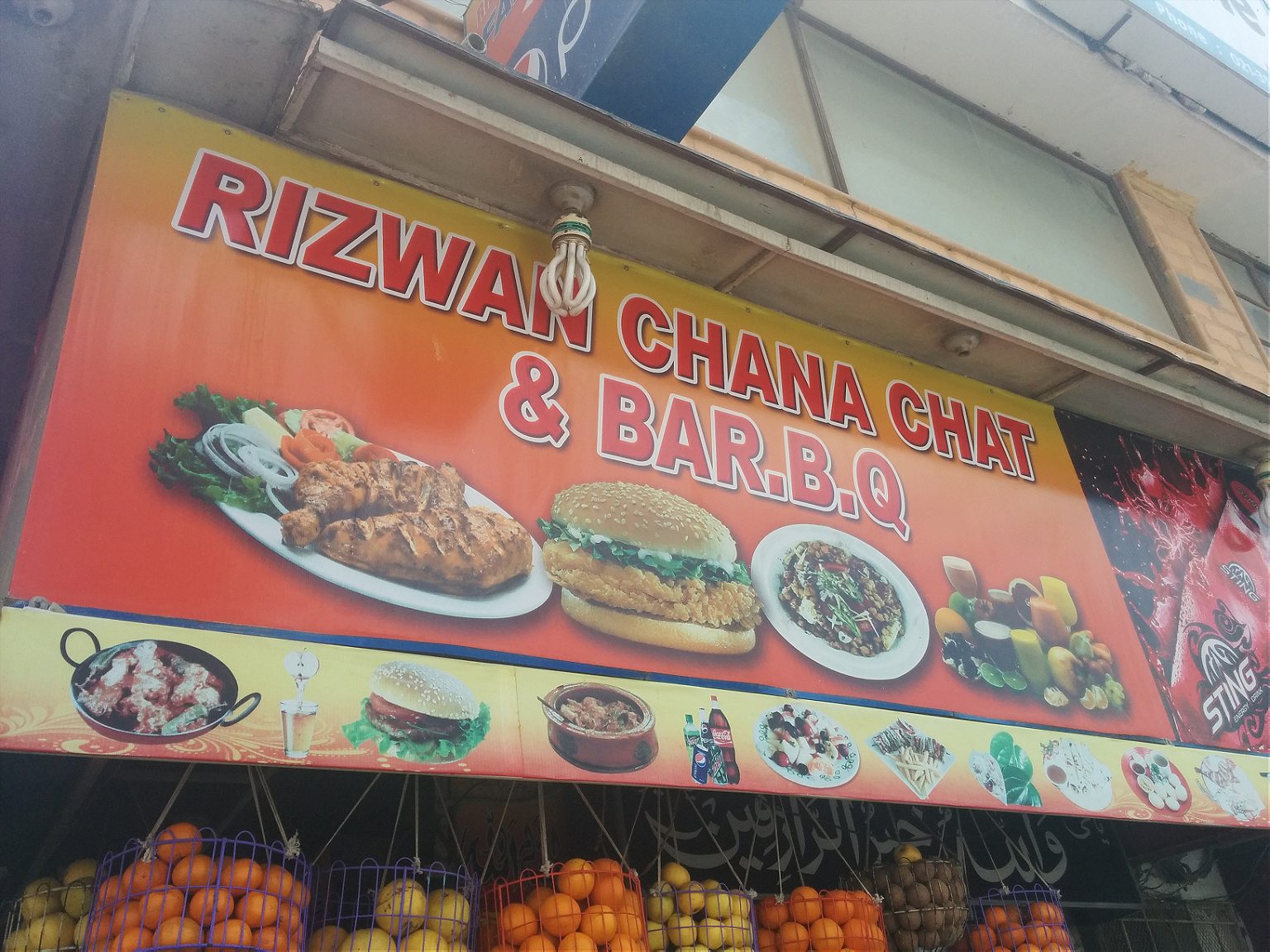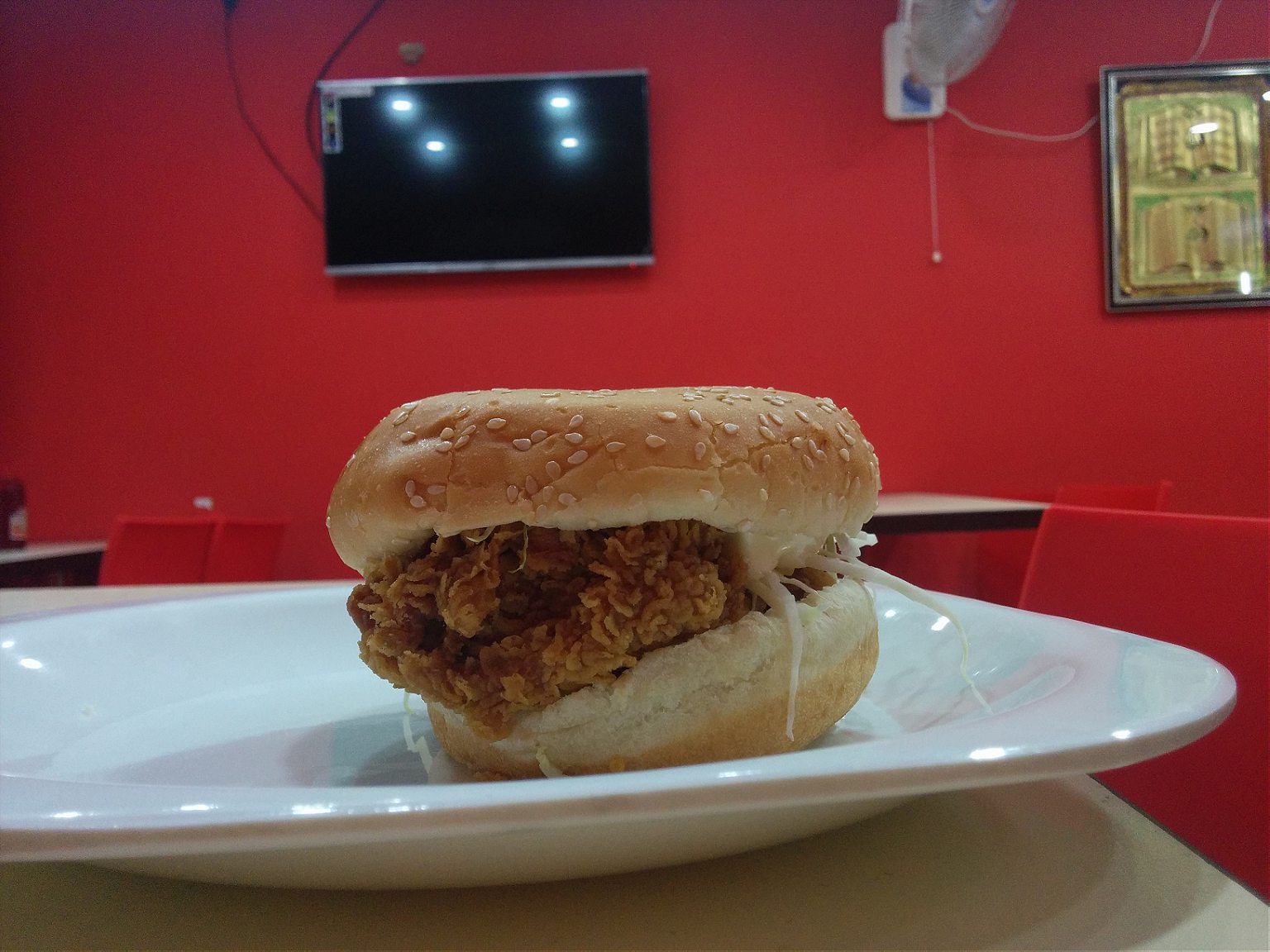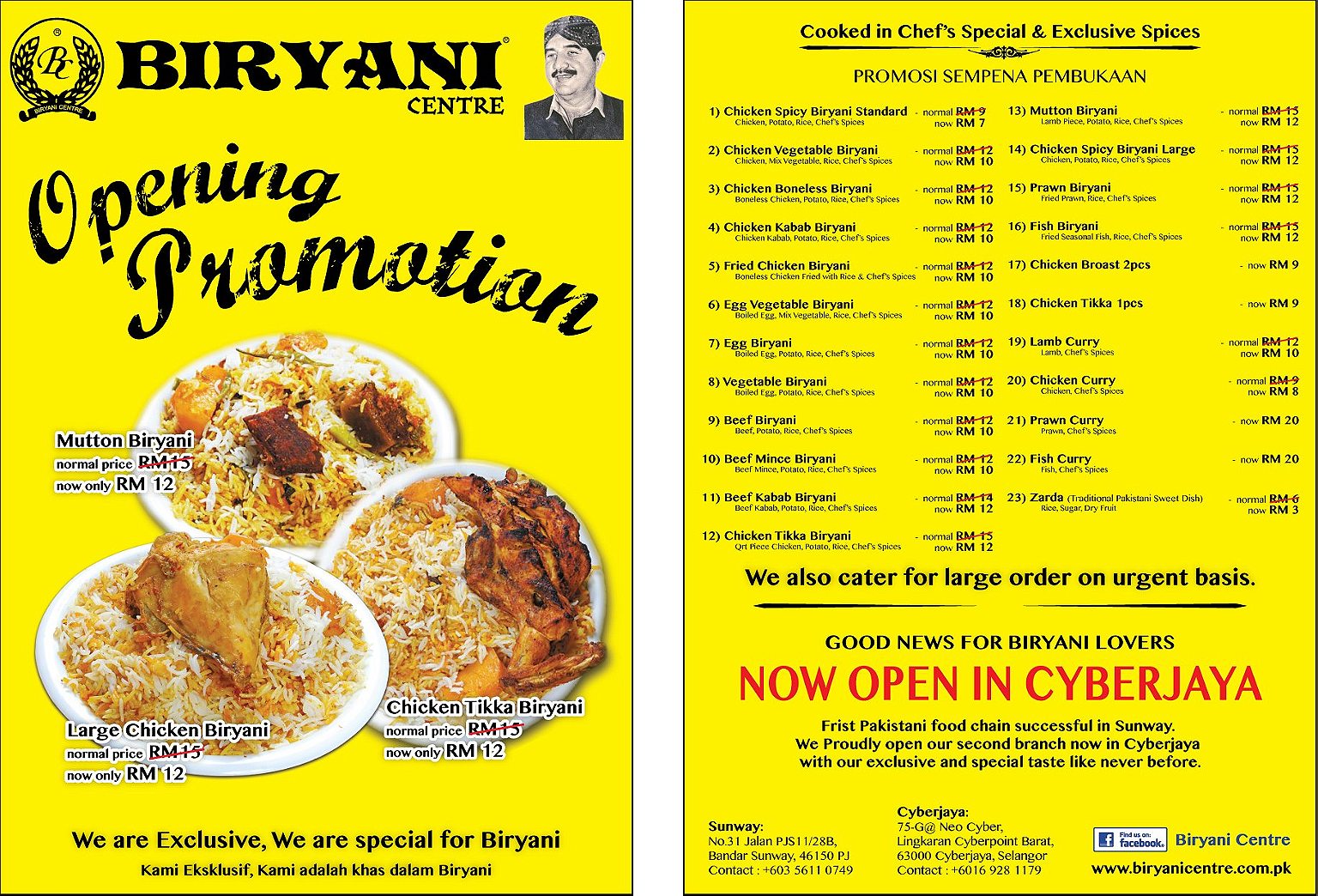Karachi’s U.S.-born Zinger Burger is neither American nor a burger. Discuss.
I am standing near the roundabout at Karachi’s famed Hassan Square, trying to decide if walking in the brutal afternoon heat is a good idea. I haven’t walked the length of this street in over a decade. There is a sign for Mukka Chowk, a roundabout that features a fist, built to commemorate the first prime minister and a symbol of the strength of Karachi’s immigrant population. I stop to stare at my old apartment building. I cross pedestrian bridges; steel traps that I am convinced will one day collapse and send me plummeting to the ground. These streets were mine; now I am a stranger here, asking for directions.
I finally get to my destination: a patch of pavement. It is anticlimactic, to say the least. There is no marker here, no sign to show that this is the birthplace of a food culture. There is a furniture store here instead. But 19 years ago, this is where one of Karachi’s most popular foods was born, second only to the ubiquitous “roll,” a kebab wrapped in a paratha.
This isn’t the story of an indigenous creation, something dreamed up in a tiny kitchen by aspiring cooks with inspiring stories, or the innovative iteration of a local product.
I speak instead of the Zinger burger made by KFC, the American fried chicken franchise synonymous with buckets and binges. The Zinger is a batter-coated, fried patty in a bun, with a slice of lettuce and mayo and cheese. The Zinger sold in Pakistan doesn’t have the zing of spice one would associate with the name. The patty is fairly mild, though KFC did try a spicier version that didn’t take off.
But this is not a mere burger; indeed, purists would argue it’s not a burger at all. In Karachi, the Zinger is a symbol of urban aspirations and dreams, a burger that sustains a city constantly in flux. It’s not just a burger. It’s Karachi’s burger.
The wealthy returned to Gulshan for the launch of KFC
When KFC opened its first branch in Karachi, Pakistan in 1997, it picked the upper-middle-class neighborhood of Gulshan-e-Iqbal as its first location, even though its richest residents had started decamping to the enclaves of the army-run Defence housing development, making Gulshan just a tad down-market. But the wealthy returned to Gulshan, driving past Hasan Square, for the launch of KFC.
People jammed into the glass-fronted restaurant for days on end. At one point, KFC had to call in the Karachi police for help managing the door. Far from being the run-of-the-mill fast food restaurant that KFC was in America, in Karachi, KFC became a symbol of wealth, of the ability to spend a hundred rupees on a burger at a time when a two-bedroom flat in an upscale neighborhood rented for five thousand rupees. People bragged about getting into KFC every night. Being seen at KFC wasn’t just about eating out. It was about gaining a bit of foreignness, being on the right side of the glass windows, and eating the same fried chicken served in Dubai and America.
What those diners didn’t know was that the Zinger wasn’t sold in the United States; it is only now being rolled out in U.S. test markets. But it had been successful in the Middle East, and KFC put it on its launch menu for Pakistan.

“The Zinger is called the King of all Burgers,” Mahad Sohail pronounces over the counter. I am waiting for the punch line, or the inevitable sarcasm hardwired into Karachi’s residents, but it isn’t forthcoming.
Sohail doesn’t work for KFC, but for Burger Hut, a fast food restaurant in Karachi’s Gulistan-e-Jauhar district. Outside Burger Hut, a lit-up sign is a beacon call of sorts: Zingers for 99 rupees, less than one U.S. dollar. Burger Hut isn’t the only contender in the Zinger market. Down the road are half a dozen other restaurants selling the Zinger burger in all forms: priced at 99 rupees to 170, with cheese or without.
By the early 2000s, KFC-style restaurants—including a venture launched by former employees—had popped up across Karachi and the rest of Pakistan. Many were designed to look like the glossy American import. While they enjoyed an initial run of success, with names like Channal Fried Chicken and Halal Fried Chiks and Al Najam Fried Chicken, they could never quite match up to the exalted ideal, nor could they offer the standardized service of Western fast food chains. They were conspicuous as copies. Mixed in with the smell of deep fried chicken was the realization that this was, still, local. These copycat restaurants mostly closed or expanded into all-out fast food, serving fried chicken and pizzas and burgers and barbecue.
That did not, however, stop the Zinger from being aped to kingdom come by restaurants that made no claim on the KFC experience. It is now the mainstay of every small restaurant, shack, and cart in Gulistan-e-Jauhar and Gulshan-e-Iqbal and Defence and beyond. It is hard to imagine a neighborhood that does not have a shop selling a Zinger. Zingers are sold at a snack bar in Keamari, next to the Karachi harbor, on carts near the Sakhi Hasan graveyard in the north of Karachi, at old-school fast food places in the city’s once-leafy suburb-like neighborhoods. Every menu and poster features the same image taken off the KFC website: a perfect bun, a thick patty, a slice of lettuce. The image is burned into Karachiites’ memories, just as the word Zinger is synonymous for burger, which here means a fried chicken patty. Gourmet beef burgers became a big trend in 2014, but the Zinger has managed to outlast it all.
“Everyone knows it as a Zinger,” Sohail says when asked why Burger Hut didn’t just sell the burger under a different name.
There is a subculture of Zinger loyalists. They are a strange breed. They don’t eat just one Zinger. Zinger aficionados treat the burger with the the kind of reverence usually reserved for more rarified foods, comparing size, quality, oil, condiments, cooking time. Zinger recipes abound on YouTube. Everyone has their favorites, their go-to shack or stall or restaurant that does the Zinger better, that provides more value for money, that delivers the right ratio of crispiness to bun, that is infinitely more satisfying. KFC may have introduced the Zinger, but it has taken on a life of its own over the ensuing years. On Foursquare, users recommend the “yummy” Zinger at Karachi favorite Kaybees, or the “amazing Zinger burger” at Royal Ice and Spice, or the “jumbo Zinger” at Red Apple, an old-school kebab roll joint.
What is it about the Zinger? The Zinger isn’t the best burger; it isn’t the cheapest, the better made, the purest. It has a specific scent; an almost sickeningly overpowering smell that’s even more distinct than the overpowering smell of oil and fryers. It is not a gourmet burger. It is probably not even the best mass produced burger. But the reality is that one of Karachi’s beloved meals came straight off an assembly line and onto a largely unsuspecting nation.

Faisal Shakeel, who joined KFC in its first year and now runs its delivery operations in Karachi, recalls serving a customer in the 1990s that came in every day after a workout and ordered a Zinger with seven additional slices of cheese, as well as a former colleague who ate a Zinger for every meal, every day, for eight years. The restaurant’s largest delivery order for the burger in recent history clocked in at a whopping 120 Zinger burgers.
“People are attracted to it for its beauty,” says 20-year-old Nadeem, who began working at the Rizwan Chana Chat House in Defence five years ago, when the Zinger came on the menu. His shalwar kameez strains his heavyset frame as he expounds on the Zinger.
It has, he says, obviously become a status symbol. But according to Nadeem, a Zinger is a Zinger, regardless of where it is made. “The quality is the same. People are just charging for the place,” he says dismissively of KFC’s prime locations and interior. Even though KFC has become more down-market than its exclusive origins, the perception persists. “The only people who go there are rich brats,” he says, though he’s tried KFC’s Zinger as well. “That’s what they’re charging money for.”
But Karachi offers plenty of options. At Boat Basin, you can get Zingers at any price. A strip of restaurants in Karachi’s upscale Clifton area, Boat Basin is home to a breakfast spot popular with the students of the city’s nearby elite schools and universities, a fast food restaurant called Chick-n-Chips—with its “Special Zinger”—and a KFC branch. On a weekday night, the outdoor tables seat families and solo diners staring at the traffic.
Anwar Ali sits among them. He works in the shipping industry and was so enamored with the Zinger that he ate Zingers almost a dozen times a month. Ali and his family have since moved onto other snacks —kebab rolls, a chicken karahi—and on a weekday night, they’re picking at a plate of fries. “We used to eat it at least 10 to 12 times in a month,” Ali admits, buying the Zingers from their neighborhood snack shop. “It’s probably once a month now.”
“Perhaps we ate too much of it,” he says, when asked to reflect on how he lost his appetite for the crispy burger.
Over the years, as more foreign brands came in and the kebab roll trend kicked off, KFC lost its luster. The crowds changed; no longer were the privileged sitting inside KFC. Now it was college students from public universities on dates.
KFC became a convenient target for anti-U.S. protestors, prompting the franchise to advertise that it was a Pakistani-run business. The original branch was burned down during a riot in 2005, and six people died in the attack.
The Zinger is not a burger, but a concept
But that was not the end of the Zinger. If anything, it was just getting started.
If there was a Biryani King title, Amanullah Khan would buy a crown. The man behind a local chain of biryani restaurants, Biryani Centre, describes himself as a visionary and a creative. He waxes lyrical about how he revolutionized biryani by introducing the idea of aluminum foil packaging for the rice dish and talks about a branch of the restaurant that he’s opened in Malaysia. Global domination is on the agenda. Variations of biryani at Biryani Centre feature quail, beef, chicken tikka, and, as of 2016, the Zinger.
Khan has a shock of clearly dyed black hair and a moustache to match, a slightly jarring combination with his lemon-yellow shirt, a color I later realize almost matches the signage of his restaurants. The prerequisite flashy watch favored by Karachi businessmen lies on his wrist, and he leans forward to talk. On the office walls are framed photographs of his sons’ graduations. The stairway leading to his office smells, not unpleasantly, of cooking spices. An employee sits on the stoop next to bags of garlic and cuts a pile of greens, though Khan brags that cleanliness is his motto.
Khan calls his restaurants “showrooms for biryani,” though they resemble diners. Biryani is a classic meal from South Asia: rice flavored with spices and cooked with meat, chicken or seafood. It has its share of purists, like those who believe that anyone who adds potatoes to biryani (a Karachi affectation) is essentially committing culinary blasphemy.

Khan is deeply committed to biryani. But he doesn’t want to serve just plain old biryani. “People demand change, people need change,” he passionately argues.
“This was in my mind for a long time,” he says. “KFC introduced the Zinger, and now everyone has it. I’d been working on it for a while, and now I’ve been successful in launching it, and I’m getting a good response.”
The idea of a burger and a biryani together seems unfathomable at first, but only if you think of the Zinger as a burger, not as a concept.
“The bun is one thing, the Zinger is another, the combination is a Zinger burger,” Khan says. “If a Zinger can be in a bun, then why can’t there be Zinger biryani? So this is my creation. I thought there must be people who don’t like eating a bun every day and want a different taste. A Zinger eater gets a Zinger at a burger shop, or at KFC. But you can’t find Zinger biryani anywhere. If you go to KFC and ask you won’t get it.”
There is no image of the Chicken Zinger Biryani, which I imagine is shredded, spicy fried chicken pieces strewn liberally on biryani. On a weekday afternoon, I decide to see for myself; when I ask for the Zinger biryani, the waiter feels compelled to double-check my order.
It is a work of art. I am no longer doubtful of Khan’s creative vision. A large, puffed up piece of fried chicken occupies almost half the dish. The rest of the plate is piled high with biryani rice sprinkled with distinct clumps of spice. I dig in and find that I can’t stop eating. Perhaps the Zinger and the rice make for an even more compelling combination than the original.
Khan is turning the Zinger into an even more democratic product; taking it out of the fast food chains and roadside shacks and into the world of local cuisine.

He has more ideas in the pipeline; all part of his goal to foster a biryani empire. “My main focus for biryani is that I want to take it to the world as an Eastern fast food, [to show] that at any level biryani is no less than a burger, than a Zinger, than Nando’s,” he says, calling on God to grant him success.
Khan isn’t the only one using the Zinger as an ingredient. Fast food restaurants offer kebab rolls that feature pieces of chicken fried à la Zinger, resulting in entrees like the “Crispy Zinger Mayo Roll.” Karachi’s restaurateurs now know that their sales come from selling Zingers to the students with insatiable appetites, to families who no longer care about the box a Zinger comes in, who only want the crispy patty with the ideal image.
Biryani Centre’s main branch is a few miles away from an old KFC branch. There is little sign of its former glory. There are no Rich Kids of Karachi here; just a couple of boys eating quietly and people waiting for their takeaway orders.
The KFC menu doesn’t list a price for a solo Zinger—one must get it with fries or fried chicken—and so my attempt to purchase a single burger causes a similarly dismayed reaction as my order of Zinger biryani. “Just a Zinger? JUST a Zinger?” echoes down the assembly line.
It still feels uncomfortable and kind of wrong to be spending so much money on fast food, and my middle-class guilt is hard to overcome as I hand over a five-hundred rupee note. When I open the box, the burger is smaller than I remembered, smaller than the image that I’ve seen plastered around town, almost as if the years haven’t been kind to it. It goes down quickly, but I feel like I need to walk for miles to dislodge the heaviness settling into my stomach.
But a few days later, I can’t stop craving crunch and spice. Perhaps this is why the Zinger works. Mixed in with the heaviness of the carbs and fat is nostalgia for our younger selves, standing on either side of the glass door, divided into the people who eat Zingers, and those who settled for the meals that could never match up to a stock photo.